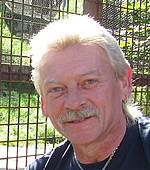Ian Abbotts, Food Technical Consultant
Ian spent a number of years working in food manufacturing before joining Marks and Spencer where he spent 25 years working with their existing and new suppliers in helping them to achieve the required food safety and hygiene standards. Ian’s expertise lies in real, hands-on, practical food safety assessment and management. He has now established his own Food Technical Consultancy and Training businesses and works with a wide range of major food manufacturing clients both in the UK and internationally. He has spent many years working in all manufacturing sectors from long life ambient foods to short shelf-life chilled high risk foods. Ian is noted for his constructive, highly effective and engaging approach in assisting food manufacturers to improve and in finding practical solutions to food safety and hygiene problems. He also has extensive experience in the hygienic design of new food factories having been involved in many new-build projects.
Abstract - ‘The consequences of failure’
The consequences of poor hygienic design of both food production equipment and building structures and layout can be disastrous for a food manufacturing company and its customers. If equipment is difficult to access and clean, this can result in serious microbiological, pest or foreign contamination of products. The financial cost to the manufacturer can be huge, but all too often it is the loss of trust and credibility with its customers which is the most damaging. This can also result in the long-term damage of business being taken permanently away from the manufacturer. Ian’s presentation looks at a number of practical examples of poor hygienic design where the consequences have led to major losses of business and company reputations.
Laurence Blayo, Nestle, Switzerland
 Laurence Blayo started her career in 1994 as factory Quality Manager in the meat industry in France. In 1996 she joined the Nestlé group in Sweden as a Microbiologist in their Research and Development Center dedicated to Frozen and Chilled Food.
Laurence Blayo started her career in 1994 as factory Quality Manager in the meat industry in France. In 1996 she joined the Nestlé group in Sweden as a Microbiologist in their Research and Development Center dedicated to Frozen and Chilled Food.
In 2000, she moved to Switzerland as a hygienist for 3 years during which she was exposed to the challenges of Hygienic Engineering during trouble shooting and training in various Nestlé, comanufacturer’s and supplier’s factories all over the world.
In 2003, she returned to France as Quality Manager for the Chilled Culinary division. In 2006, she became Food Safety Manager for Nestlé France until 2009, when she returned back to Switzerland to occupy her present position. She is currently leading the Food Safety Microbiology team at the International Nestlé Research Center based in Lausanne, Switzerland. Her team is dedicated to Emerging Microbial issues and Microbiological Risk Assessment. She is leading as well the Nestlé R&D Microbiological Safety Expert Network aiming at developing the critical mass of food safety microbiologists and leveraging the overall microbiology competences throughout the Company.
Laurence Blayo has built over the years considerable expertise in Food safety, Hygiene and Hygienic Engineering . Her passions include not only Microbiology and Food Safety sciences but also people management and development. She holds a MSc in Microbiology and Food Safety from the Brest high school of Microbiology and Food Safety in France.
Abstract - Requirements on Hygienic Design from Food Manufacturers to equipment Suppliers
It is the food manufacturer’s responsibility to know the profile and risks of the products they manufacture and monitor all food safety parameters including equipment design. They must buy properly designed, easily cleaned equipment and maintain it in sanitary condition through good planned cleaning and maintenance. To do so, as for any other incoming materials (ingredients, packaging materials), food manufacturers need to define their requirements, select and approve suppliers against these requirements and verify that the delivered equipment meet the defined requirements. In this talk, requirements of food manufacturers to equipment suppliers will be presented. Challenges will be as well addressed.
 Dr. Thomas Caesar, Freudenberg Filtration Technologies, Germany
Dr. Thomas Caesar, Freudenberg Filtration Technologies, Germany
Thomas started in 1999 at Freudenberg and is since then working in air filtration, first as Applications Engineer and later as Market Manager for Contamination Control. As Global Director Filter Engineering Industrial Filtration, Thomas today is responsible for product segment engineering, product development and testing at Freudenberg Filtration Technologies, a worldwide leading supplier of air filtration solutions. Besides this, Thomas is German delegate to CEN/TC195 and ISO/TC142 and expert in various working groups at ISO and CEN. He is Vice Chairman of the Product Group Air Filters at Eurovent Association and Chairman of the Eurovent Certita Certification Compliance Committee for Air Filters. At EHEDG, Thomas is Chairman of the Working Group Air Handling.
Abstract - EHEDG Guidance documents and working groups
Assurance of quality and safety is an essential need for the continued good reputation of foodstuffs. The correct hygienic design and maintenance of food production systems is considered as a prerequisite to fulfill these requirements. In order to offer help to the industry in these questions, EHEDG develops, publishes and maintains a variety of currently 47 practical guidance documents on adequate hygienic design in different areas of food production equipment and machinery, as well as on the food manufacturing infrastructure.
These guidance documents are developed and maintained by respective working groups under the umbrella of the EHEDG sub-committee "Product Portfolio". The Working Groups at EHEDG are permanent and consist of various experts who cover a broad expertise needed for the assigned tasks. As the tasks may vary over time, also the Working Group composition my change depending on the required expertise. Once a guidance document has been drafted by an EHEDG Working Group, it undergoes different levels of peer review and approval before publication. The process of drafting a guidance document at EHEDG is shown at the example of the recently published Document 47 "Guidelines on Air Handling Systems in the Food Industry - Air Quality Control for Building Ventilation".
Prof. Dr. John Holah, Technical Director, Holchem laboratories
 John Holah is an applied microbiologist whose work has focussed on the prevention of microbial, chemical and foreign body contamination of food during its manufacture, distribution and retail. John has an extensive knowledge of the food industry, having worked within >500 food factories and catering establishments, in the UK, Europe, North and South America, Africa, Asia and Australia.
John Holah is an applied microbiologist whose work has focussed on the prevention of microbial, chemical and foreign body contamination of food during its manufacture, distribution and retail. John has an extensive knowledge of the food industry, having worked within >500 food factories and catering establishments, in the UK, Europe, North and South America, Africa, Asia and Australia.
John has a passion for food safety and food hygiene and has been responsible for establishing many GMP/GHP’s used in the food industry for the control of pathogens, particularly Listeria, Salmonella and E. coli. He has undertaken specific investigations into microbial contamination incidents in factories from SME’s to multinational companies and has worked at a Corporate level to advise major international companies on developing HACCP, prerequisite and quality systems to provide an integrated food safety plan. He has specific expertise on the hygienic design of food factories and food processing equipment; factory services and water systems; maintenance; cleaning and disinfection; personnel hygiene and environmental sampling.
At an academic level, John has led several European and national research projects, has written over 100 publications, given over 200 external presentations, edited several books, has a wide range of teaching experience at all levels from industry to University MSc courses, and has been external supervisor to more than 15 PhD students.
John has represented the UK on CEN/TC 216/Chemical disinfectants and antiseptics, chaired ISO/TC 199/WG2 on the Hygiene requirements for the design of machinery, is an active member of the European Hygienic Design of Equipment Group (EHEDG) and was a member of the National Health Service Rapid Review Panel.
John is the Technical Director at Holchem Laboratories, the UKs largest supplier of food hygiene services to the food manufacturing industry. John’s current responsibilities include the development of innovative cleaning and disinfection chemicals and technologies and their successful utilisation in effectively designed, engineered, validated and managed sanitation programmes.
John is an Honorary Professor of Food Safety at Cardiff Metropolitan University and was previously Head of the Food Hygiene Department at Campden BRI.
Abstract - Hygienic design of food production premises
Hygienic design of food production premises has progressed over the last 30 years from simply trying to prevent pest entry to food production areas to being an essential prerequisite in our management of both microbiological and chemical (allergen) food product contamination. It has also had to consider the threat of deliberate food contamination and brand protection issues whilst at the same time providing a suitable infrastructure for flexible and economic food production. Hygienic design provides the following benefits.
- Defence against external food safety hazards (pests, microorganisms, particulate and chemical contamination).
- Defence against internal food safety hazards (microorganisms, allergens, foreign bodies).
- Defence against internal brand protection issues such as meat (in vegetarian products) and meat species.
- Internal flows of people, product, packaging, dismantled equipment, air and wastes to prevent cross-contamination.
- Security against deliberate external and internal contamination.
- The maintenance of hygienic conditions via structure rigidity – appropriate foundations, steelwork, floor slabs.
- The Maintenance of hygienic conditions via material durability.
- Consistency and safety of cleaning and disinfection provision.
- Compliance with customer/GFSI best practice.
 Eric Partington, Regional Section Chair, UK & Ireland EHEDG. European Consultant, Nickel Institute
Eric Partington, Regional Section Chair, UK & Ireland EHEDG. European Consultant, Nickel Institute
Eric Partington is a Metallurgist with some 40 years' experience of food and drinks production in the United Kingdom. He is a European Consultant to the Nickel Institute of Toronto, specialising in the applications of stainless steels in the Food and Beverage industries. He has lectured and published extensively on EU food safety legislation, selection of food contact materials and the hygienic design of food-processing equipment in the UK, Europe and Asia.
Eric is Chairman of European Hygienic Engineering and Design Group's Regional Section for the UK and Ireland.
Abstract - WHAT IS HYGIENIC DESIGN AND WHY IS IT IMPORTANT?
Hygienic design is fundamental to safe food production. It is essential at every stage in the process; from the layout and construction of the buildings in which food is prepared to the packaging in which it will be put onto the market. Taking food processing equipment as an example, the importance of selecting the right materials for the job and of designing with them, assembling them and maintaining them skilfully will be discussed. The legislation applicable to food contact materials and to equipment design will be put into this context, and the question of whose responsibility it is to ensure compliance will be addressed.
This presentation aims to 'set the scene' for the specialists who are to follow.
Debra Smith, Global Hygiene Specialist
Debr a has over 30 years of food safety/research training and experience.
a has over 30 years of food safety/research training and experience.
Prior to joining Vikan Deb worked in the microbiology laboratory of Bernard Matthews Farms, a large poultry farmer and processor (3 years), the Food Safety Division of the UKs Dept. of Environment, Food and Rural Affairs, as a Research Manager (DEFRA, 16 years), and as Food Hygiene Research Manager at Campden BRI (9 years).
She holds qualifications in Applied Microbiology (HNC), Nutrition & Food Science (BSc (Hons)), and Advanced Food Hygiene and HACCP. She is also a qualified FSSC 22000 auditor.
Deb is author/co-author of numerous food safety/hygiene publications, including peer reviewed papers, book chapters and a number of food industry hygiene guidelines. She has also presented her research at many National and International food safety events.
At Vikan Deb is responsible for providing expert hygiene advice and support to the food industry and for the development of new and improved cleaning tools. She is also available to conduct hygiene site visits and Workshops, and provide bespoke hygiene training and advice.
 Andy Timperley, Approved EHEDG Trainer, Timperley Consulting
Andy Timperley, Approved EHEDG Trainer, Timperley Consulting
Andy Timperley is an Hygienic Design Engineer, working as an independent Consultant to the Food Industry since 2006. He has over thirty five Years’ experience in engineering related disciplines since joining BHR Group in 1980 and subsequently Campden BRI in 1988. Andy also provides hygienic design consultancy to the European Standards Organisation (CEN) as the named UK Hygiene Expert representing BSI for hygienic design issues relating to plenary and machine specific 'C' Standards. In February 2004, Andy became the first European based Certified Conformance Evaluator (CCE) for 3-A Sanitary Standards Inc. Andy has been an active Member of EHEDG since 1989 and, in June 2006, was elected Chairman of the EHEDG Test Methods Subgroup. In January 2009 Andy qualified as a CCE for the P3-A group of Standards for pharmaceutical equipment.
Andy’s specialist areas include:
- Providing consultancy on hygienic equipment design, selection and system design issues for equipment manufacturers, system designers and food producers.
- Conducting hygienic design audits and troubleshooting in food factories.
- Providing material for EHEDG guideline documents on hygienic design of equipment and training courses.
- Producing Hygienic Design Guidelines and developing Test Methods documents in conjunction with the European Hygienic Engineering and Design Group (EHEDG).
- Performing practical assessments of in-place cleanability, steam sterilisability and bacteria tightness for closed items of food processing equipment according to the EHEDG test procedures.
- Conducting third party inspections of equipment and issuing Certification documentation in conjunction with the EHEDG Certification Scheme.
- Conducting third party verification (TPV) inspections of equipment on behalf of 3-A Sanitary Standards Inc. and issuing TPV reports to support the application of 3-A symbols.
- Conducting hygienic design training courses as an authorised EHEDG Trainer and developing tailored training courses for specific Companies
Abstract - Verification of Hygienic Design; Test Methods and Certification
Over the last 27 Years EHEDG has provided the food and allied industries with 47 best practice guideline documents and become an internationally recognised authority on hygienic engineering and design. Some of the first documents to be issued by EHEDG were test methods for evaluating the hygienic and aseptic capabilities of equipment. Since the Year 2000 EHEDG has been operating a Certification Scheme for equipment based on practical assessments of hygienic design and clean ability. This Scheme has been revised and expanded over the Years to further enhance the deliverables provided to industry. This presentation gives an overview of the test methods and structure of the current Certification Scheme. Additionally, EHEDG is funding research into developing new clean ability test methods to support the Certification Scheme for equipment and components.
Abstract - Hygienic Design Considerations for Food Processing Equipment
EHEDG recognises the need to regularly review and update existing guidelines as well as create new ones based on the needs of equipment manufacturers and food producers to provide safe food in increasing quantities cost effectively. From choosing the appropriate materials and applying hygienic design principles for the construction of the equipment through the integration process of that equipment into a qualified process to the design of the facilities and environment in which the food will be produced there are many areas where EHEDG can provide guidance in order to enhance efficient and safe food production.
Currently, the Hygienic Design Principles Guideline Document No. 8 is being updated and this presentation summarises the fundamental considerations for hygienic design, including: materials of construction and surface finish, hygienic design principles and installation of the equipment.
Patrick Wouters, PhD, Global Hygienic Design Lead, Cargill B.V., Netherlands, Vice President, European Hygienic Design & Engineering Group
Patrick leads the Global Hygienic Design Centre of Expertise and community of practice, and is responsible for increasing collaboration and visibility of food safety engineering principles, standards and technologies throughout the Cargill organisation. Core responsibilities include the development and promotion of hygienic equipment and facility design and other technologies that contribute to the production of safe products in existing plants and in new projects. Prior to Cargill, Patrick worked for 22 years in Unilever and had various roles in R&D and Quality Management. Member of the EHEDG Executive Committee since 2010, and Vice-President of EHEDG as of 2011.
Abstract - Who are EHEDG and what can they do for me?
Foundational to food safety and quality is hygienic design of equipment and facilities. The European Hygienic Engineering & Design Group (EHEDG) is a non-profit foundation (trust) whose mission is to enable safe food production by providing guidance as an authority on hygienic engineering and design. This is done by supporting the food industry in the development of consensus based design and engineering guidelines, equipment certification schemes, and training and education programs.
The expanding EHEDG expert network provides practical guidance and assistance to manufacturers of food processing and packaging machinery, food manufacturers, national and international regulatory organisations and other stakeholders. EHEDG provides a balanced forum to discuss issues concerning hygienic design and how to ensure food safety and quality in a cost effective way.
This presentation deals with:
- Purpose and structure of EHEDG
- Product offerings and position of EHEDG in the food value chain
- Importance of hygienic engineering and design in food safety management
